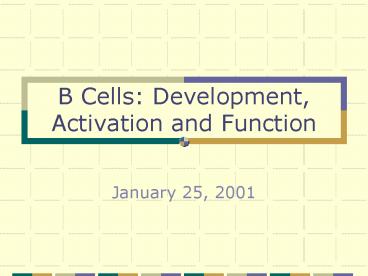B Cells: Development, Activation and Function - PowerPoint PPT Presentation
1 / 27
Title:
B Cells: Development, Activation and Function
Description:
B Cells: Development, Activation and Function. January 25, 2001 ... B Cell Activation, Proliferation. Primary and Secondary B Cell Responses. B Cell Differentiation ... – PowerPoint PPT presentation
Number of Views:251
Avg rating:3.0/5.0
Title: B Cells: Development, Activation and Function
1
B Cells Development, Activation and Function
- January 25, 2001
2
B Cells The Immune Systems Shaq Attack
3
Outline
- B Cell Development and Maturation
- B Cell Activation, Proliferation
- Primary and Secondary B Cell Responses
- B Cell Differentiation
4
- 3 Stages of the B Cell
- Generation (antigen independent)
- Activation (antigen dependent)
- Differentiation (antigen dependent)
5
Fig. 11-2
6
Fig. 11-4
7
5-6 cell divisions
Fig. 11-3
8
(No Transcript)
9
http//www.bio.davidson.edu/Biology/Courses/Immuno
logy/Flash/Bcellmat.html
10
Clonal Deletion
X
11
http//www.bio.davidson.edu/Biology/Courses/Immuno
logy/Flash/Bselect.html
12
Outline
- B Cell Development and Maturation
- B Cell Activation, Proliferation
- Primary and Secondary B Cell Responses
- B Cell Differentiation
13
Thymus-Dependent and Thymus-Independent Antigens
- T-dependent response requires physical contact
between T cell and B cell - T-independent response do not require T cell
contact - Can be divided into TI-1 responses and TI-2
responses - TI-1 (e.g. LPS) are polyclonal B cell activators
(mitogens) - TI-2 (e.g. polysaccharides) crosslink mIg
non-mitogenic, require cytokines - TI response is weaker, no memory cells are
formed, and IgM is primary antibody secreted
14
Cell Signaling/Signal Transduction
15
http//www.bio.davidson.edu/Biology/Courses/Immuno
logy/Flash/TI.html
16
Fig. 11-6
17
Fig. 11-10
18
Outline
- B Cell Development and Maturation
- B Cell Activation, Proliferation
- Primary and Secondary B Cell Responses
- B Cell Differentiation
19
(No Transcript)
20
Table 11-4
21
Hapten/Carrier Response
22
Outline
- B Cell Development and Maturation
- B Cell Activation, Proliferation
- Primary and Secondary B Cell Responses
- B Cell Differentiation
23
Differentiation in Germinal Centers (GCs)
- Germinal centers are sites in secondary lymphoid
tissues where massive B cell proliferation occurs
in response to T-dependent antigen stimulation - GCs are the sites of
- Isotype switching change in antibody isotype
without loss of specificity - Affinity Maturation - increase in antibody
affinity due to selection of high-affinity B cell
clones which arise as a result of somatic
V-region hypermutation - Differentiation into plasma or memory cells
24
(No Transcript)
25
Clonal Selection
Y
Y
Y
Y
Y
Y
Y
Y
Y
Y
Y
Y
Y
Antibody-Producing Plasma Cells
Y
Memory Cells
Y
Y
Y
Y
Y
Y
Y
26
B1 B Cells
- A small subset of human and mouse B cells, but
they arise earlier. Consequently, most typical
B cells are referred to as B2 B cells - Found primarily in the peritoneal cavity. Scarce
in the LN, spleen. - Respond poorly to protein antigens, better to
carbohydrate antigens - Many chronic lymphocytic leukemias arise from B1
cells - Role in autoimmune diseases has been speculated
27
(No Transcript)































